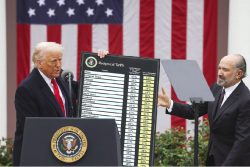Guyana’s Finance Minister Dr Ashni Singh says the country’s debt levels are lower now than they were in 1992 and more importantly they are sustainable.
In a statement today via the Government Information Agency he was reacting to news reports on Guyana’s total debt of US$1.7B as of March last year compared to the US$2.1B in 1992. Critics had noted that the figures showed that the present debt level was still high despite huge debt write-offs by the Paris Club group of debtors and by multilateral financial institutions post-1992. It had also been noted by critics that a significant portion of the US$2.1B debt racked up by the PNC government constituted accumulated interest.
The present debt figures had been provided by Singh in Parliament last Thursday in reply to a question by Alliance For Change MP Moses Nagamootoo.
Today, Singh hit back at Nagamootoo and other critics.
The Finance Minister argued that a simple comparison of the public debt in Guyana dollars is misleading as it does not take into account the movement of the exchange rate to the US dollar over the years or the growth in the economy over the years. Therefore, he said a comparison of the debt using US dollar amounts would be more accurate.
Referring to remarks by Nagamootoo in yesterday’s edition of the Kaieteur News, Singh said that Nagamootoo ignores a critical fact that one cannot assess the level of indebtedness without taking account of wealth and income levels.
“In other words, higher wealth and income levels make debt payments easier. As a result, a person or country with greater income could borrow more without putting their financial situation in jeopardy”, Singh contended.
The Finance Minister pointed out that Guyana’s total public debt declined from US$2.1 billion in 1992 to US$1.7 billion in 2012. At the same time, its gross domestic product moved from US$371 million in 1992 to US$2.8 billion in 2012.
In addition, he said that Central Government’s revenue has risen from US$141 million in 1992 to US$637 million in 2012 and Guyana’s exports grew from US$382 million (including Omai gold mine’s export proceeds) in 1992 to US$1.4 billion in 2012.
Further, he said the country’s external reserves appreciated from US$191M in 1992 to US$872M in 2012.
“In other words, over the period 1992 to 2012, Guyana’s public debt in US
dollars declined by 22 percent, while GDP, Government revenue, exports and external reserves increased by 666 percent, 353 percent, 266 percent, and 356 percent respectively.
“Put differently, in 1992, Guyana’s public debt to GDP ratio amounted to 602 percent”, Singh argued.
Singh said Guyana’s debt levels today are sustainable according to the most recent Debt Sustainability Analysis conducted by the International Monetary Fund (IMF) and the World Bank. He said this analysis evaluates the country’s debt by taking account of all debt payment obligations due in the future. The concept of debt used in this analysis, he said, is termed the “Net Present Value (NPV) of Debt” and this NPV of Debt has, in recent years stayed within the sustainable thresholds utilized by the IMF. He asserted “Clearly, Guyana’s economy and public debt is in a far better position today than when the PPP/C assumed office in 1992.”
The GINA report said that it should be noted that a key portion of the addition to the Public Debt in recent years has been the result of
the PetroCaribe arrangement with Venezuela for fuel on concessional terms. This arrangement also allows Guyana to repay a portion of the oil debt with Caracas through barters – in this case rice.
GINA noted that since 2009, Guyana has used this facility by exporting local rice and paddy to Venezuela.
As at December 31, 2012, Guyana had exported a total value of US$280
million of rice and paddy to Venezuela and during last year, Guyana completed the first round of debt compensation with Venezuela to slash the debt owed by US$100.8 million which is the value of rice and paddy bartered from December 2009 to July 2011. This would have to be deducted from the 2012 debt stock.
The rest of the value of rice and paddy exported to Venezuela would be discounted from the debt stock once subsequent debt compensation pacts are concluded in 2013, GINA said.
GINA added that new borrowing has been specifically targeted at those projects that contribute to economic growth and development and the improvement of the livelihood for all Guyanese.







